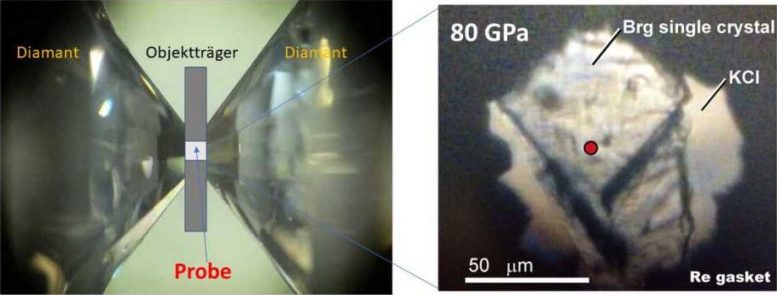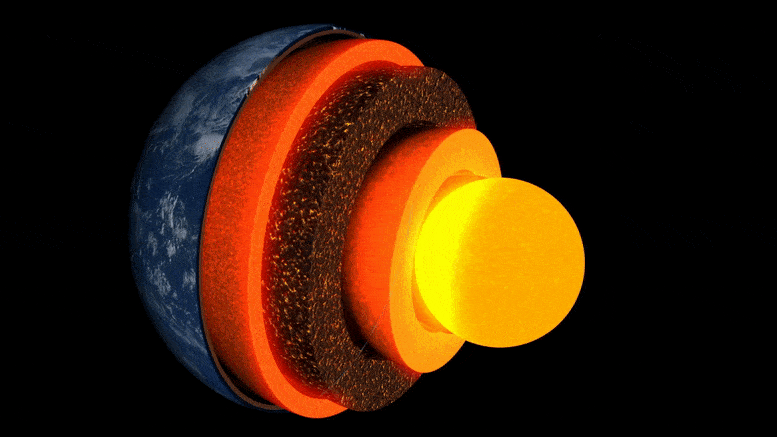Researchers at the Federal Institute of Technology Zurich have shown in the lab how well the base mineral at the core-mantle boundary conducts heat. This leads them to suspect that the Earth’s heat may be dissipating sooner than previously thought.
The evolution of our planet is a story of freshness: 4.5 billion years ago, extreme temperatures prevailed on the surface of the young Earth, and it was covered with a deep ocean of magma. Over millions of years, the planet’s surface cooled to form a brittle crust. However, the enormous thermal energy released from the Earth’s interior drives dynamic processes such as mantle convection, plate tectonics and volcanoes.
However, questions about how quickly the Earth will cool down and how long it might take for this continuous cooling to stop the above thermal processes remain unanswered.
A possible answer may lie in the thermal conductivity of the minerals that form the boundary between the Earth’s core and the mantle.
This boundary layer is relevant because this is where the sticky rocks of the Earth’s mantle are in direct contact with the hot fusing of iron and nickel in the planet’s outer core. The temperature gradient between the two layers is quite steep, so there’s likely to be a lot of heat flowing here. The boundary layer is mainly composed of the mineral bridgemanite. However, researchers have difficulty estimating how much heat this mineral passes from the Earth’s core to the mantle because experimental verification is so difficult.
Now, ETH Professor Motohiko Murakami and colleagues at the Carnegie Institution for Science have developed a sophisticated measurement system that allows them to measure the thermal conductivity of bridgemanite in the laboratory, under conditions of pressure and temperature prevailing inside the Earth. For the measurements, they used the newly developed optical absorption measurement system in the pulsed laser heated diamond unit.

A measuring device for determining the thermal conductivity of bridgemanite under high pressure and extreme temperature. Credit: From Murakami M, et al, 2021
“This measurement system allows us to show that the thermal conductivity of bridgemanite is about 1.5 times higher than assumed,” Murakami says. This indicates that the heat flux from the core into the mantle is also greater than previously thought. Increased heat flow, in turn, increases convection in the mantle and accelerates cooling of the Earth. This may cause the movement of plate tectonics, which is supported by convective motions in the mantle, to slow down faster than the researchers expected based on previous values of thermal conductivity.
Murakami and colleagues also show that rapid mantle cooling will alter the stable mineral phases at the central mantle boundary. When cooled, bridgemanite turns into a post-perovskite mineral. But once postperovskite appears at the core-mantle boundary and begins to dominate, mantle cooling can actually accelerate, the researchers estimate, because this mineral conducts heat more efficiently than bridgemanite.
“Our results can give us a new perspective on the evolution of Earth dynamics. They suggest that Earth, like the other rocky planets Mercury and MarsIt cools and becomes inert much faster than expected,” explains Murakami.
However, he cannot say how long it would take, for example, for convective currents in the mantle to stop. “We still don’t know enough about these types of events to determine their timing.” To do this, it is first necessary to better understand how convection works in the mantle of space and time. In addition, scientists need to clarify how the decay of radioactive elements inside the Earth – one of the main sources of heat – affects the dynamics of the mantle.
Reference: “The radiative thermal conductivity of a single-crystal bridge at the central mantle boundary with implications for geothermal evolution” by Motohiko Murakami, Alexander F. Goncharov, Nobuyoshi Miyajima, Daisuke Yamazaki, and Nicholas Holtgrove, Dec 8, 2021, Earth and Planetary Science Letters.
DOI: 10.1016 / j.epsl.2021.117329

“Coffee trailblazer. Social media ninja. Unapologetic web guru. Friendly music fan. Alcohol fanatic.”

